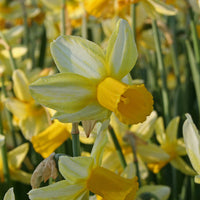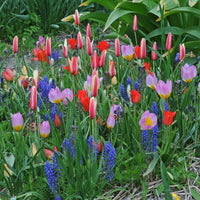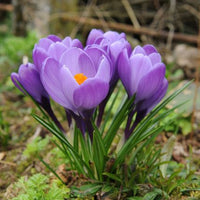It is often said that the tulip is only for 1 year. It is true that the tulip is not a perennial plant, but with a little effort it is still possible to enjoy a tulip bulb for several years.
I will explain to you what you need to do to keep the tulip bulb:
First wait until the leaves of the tulip, in your garden or in a pot, have completely died off. Make sure that the soil, especially in the pot, remains sufficiently moist in the period after flowering until it dies off. This is the period that the new tulip bulb develops and water is also needed for this.


It is often said that you should remove the faded tulip flowers so that the tulip does not put energy into the formation of seed buds. I never do this, the tulip does not make seed buds that often and when it does make them they are quite graceful.
When the tulip has died and the leaves are completely brown, you take the tulip bulbs out of the ground. You will see that the tulip bulb looks very different from the bulb you planted last autumn. It is dark in colour and surrounded by a layer of old skins. These are the remains of the tulip bulb you planted last autumn. During its growth into a tulip flower, it has sucked the tulip bulb completely empty in order to present itself as a flower as beautiful as possible.
If you peel away these old skins, a beautiful shiny new bulb will appear. This is the flower bulb that has grown in your garden or pot after flowering.


What you need to do now is remove all the old skins: the so-called peeling of the tulip bulbs. Do this carefully so that the outer light brown skin of the new tulip bulb does not come along. This is the skin of the new tulip bulb. This skin provides protection against damage and drying out.
You can also choose to let the freshly dug bulbs dry for a few days first. Sometimes it is easier to peel the bulbs then. I always choose to do it immediately so that the peeled tulip bulbs can dry quickly.
You will also certainly find a number of small tulip bulbs. Sometimes 2 or 3 with each bulb, but often there are fewer. I always throw these small bulbs away, they will certainly not produce a flower next year. You often have to look after them for 2 years before they are big enough to flower again. It can also happen that you only find small bulbs in the old tulip bulb. If that is the case, the conditions have not been good for the tulip to grow and you would be better off buying new tulip bulbs .
Put the beautiful tulip bulbs you have peeled in an airy bag and hang them somewhere in the shed, garage or in your house on a nail. If you do not have a bag, you can also use old pantyhose (I once saw them at a gardening friend, they looked quite nice). I like to hang the bags somewhere so that the bulbs are kept well airy and the mice cannot get to them.

You may wonder why you can't just leave the tulip bulbs in the ground. It is just a little too cold in the ground for the tulip bulb. During the summer months, the new tulip and its flower grow inside the tulip bulb, in miniature form, which must bloom again next spring. The tulip bulb needs warmth for this; a temperature of around 20 degrees Celsius. It is often considerably colder in the ground in your garden. There are tulip species that develop their flower well at lower temperatures. These are tulips that are more closely related to wild tulips .
Also, in our soil it is often too moist in the summer, which can cause the tulip bulb to mold or rot. The tulip bulb can also fall prey to all kinds of pests in the soil.


In October – November, when the leaves fall from the trees, you can plant your tulip bulbs again . You will see that a green tip is already emerging from the nose of the bulb. If you were to peel this bulb open, you would be able to see the entire tulip with its flower in miniature form. This has grown in the heart of the tulip bulb in your shed during the summer months.
If you are going to try to save tulip bulbs, I wish you the best of luck and I hope you succeed.
» Also read: Storing Dahlia tubers
Kind regards,
Carlos van der Veek













 Deutsch
Deutsch English
English
